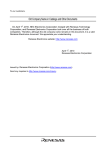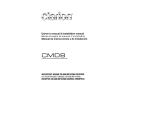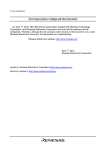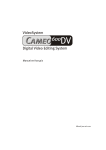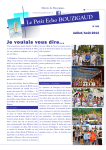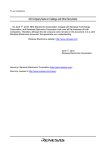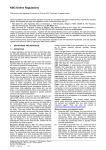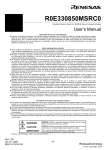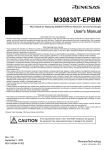Download Renesas R0E330850ACBP0 User's Manual
Transcript
R0E330850ACBP0 Protection Board for M16C/60 Series M16C/62P Group and M32C/80 Series Emulator User’s Manual CAUTION Renesas Tools Homepage Rev.1.02 Jan. 08, 2008 REJ10J1734-0102 If the requirements shown in the "CAUTION" sentences are ignored, the equipment may cause personal injury or damage to the products. http://www.renesas.com/tools (1/8) 1. Outline LED1 40b 1b 40a 1a TOOL SIDE 40 b 40 a 1b 1a R0E330850ACBP0 protection board MADE IN JAPAN Pb Free The R0E330850ACBP0 is a protection board for the M16C/60 Series M16C/62P Group and M32C/80 Series emulator. This product protects the emulator from improper connections by connecting to between the converter board and emulator. This product is designed to protect the emulator from troubles caused by applying overvoltage to port pins. Note that it cannot protect the emulator when applying overvoltage or reverse voltage to the power pins, or applying more voltage than the allowable voltage to each pin. R0E330850ACBP0 User's Manual (Jpn/Eng) J2 J1 LED2 R0E330850ACBP0 REV.A RENESAS RENESAS R0E330850ACBP0 R0E330850ACBP0 ユーザーズマニュアル User's Manual ルネサス テクノロジ www.renesas.com 2. Package Components (See Figure 1) (1/*) Renesas Technology www.renesas.com (1/*) Figure 1 Package components of the R0E330850ACBP0 (1) R0E330850ACBP0 protection board ......................... 1pc. (2) R0E330850ACBP0 User's Manual (This manual) ..... 1pc. (2) R0E330850ACBP0 User's Manual (Japanese)........... 1pc. 3. Specifications Table 1 Specifications Applicable products Interface connectors Vcc Protect function Protected pins* M30830T-EPB, M30850T2-EPB, M30870T-EPB, M30880T-EPB, M3062PT2-EPB, M30850T3-CPE, M30870T2-CPE, M3062PT3-CPE 80pin 0.8mm pitch (Matsushita Electric Works, Ltd.) 3.0 - 5.5 V (When the power pin Vcc1 is set to 5.6 V or more, LED1 and LED2 light.) Overvoltage: When applying voltage up to +10 V, the input voltage is limited by a diode. Reverse voltage: When applying voltage up to -10 V, the input voltage is limited by a diode. Over current: When the signal is short-circuited, the current is limited. Signal input/output pins except pins below. Pins not protected: Vcc1, Vss1, Vcc2, Vss2, AVcc, VREF and AVss (Note that pins of BYTE, CNVss, P70 and P71 are not protected against overvoltage) Max.120 mA (without error) *Power is supplied from the Vcc1 pin of the user system Icc Insertion/removal 50 times guaranteed iterations of connector * About protections of each pin, see “Table 2 Correspondence of the connectors”. Examples to be protected - Connection between a port and +10[V] signal - Short-circuiting between a port and ECL (-5.5[V]) output signal - Short-circuiting between output ports or between an output port and the power supply Examples NOT to be protected - Applying +9[V] to the power supply - Connection between a port and +24[V] signal (2/9) 4. Connection Procedure (See Figure 2) J3 J4 1b 1b 40b 1a 1a 40b (1) Check that neither the RVC12 nor RVS12 on this product has been disconnected using a tester. 40a 40a The procedure for connecting this product is shown below. RVC12 RVS12 - When the RVC12 and RVS12 are disconnected, this product may have been damaged because of overload. Do not connect this product with the emulator or user system. As the emulator may also have been damaged, make a request for inspection of it. (1) Check neither RVC12 nor RVS12 have been disconnected before using this product. Emulator (2) Mount this product on the converter board. Make sure NOT to use this product without the user system. Install the connectors as follows. Converter board CN1 = J3 of this product Converter board CN2 = J4 of this product (J4) (J3) (3) - Check to see if power is off. - Do not attach this product between the PCA7501EPBA board and the M3T-FLX160-EPB. - Be sure not to attach the board in a wrong direction. This product J2 Side Match the direction of the connectors J1Side (J4) (3) Mount the emulator on this product. Install the connectors as follows. Emulator J3 = J1 of this product Emulator J4 = J2 of this product (J3) (2) Match the direction of the connectors Converter board CN2 side Socket CN1 side 1pin Before using this product, be sure to read "5. Precautions" on the next page. User system Do NOT use without the user system. M3T-FLX160-EPB - - PCA7501EPBA Do not attach this product between the PCA7501EPBA board and the M3T-FLX160-EPB. Figure 2 Connection procedure of the R0E330850ACBP0 (3/9) 5. Precautions CAUTION Caution to Be Taken for This Product: z Be sure to connect this product to the user system, and supply power from the Vcc1 pin. z Use the power pin Vcc1 with 5.5 V or less. If the Vcc1 pin is set to 5.6 V or more accidentally, the LED1 and LED2 will light up to notify it. If the LEDs light up, turn the power off immediately. z If the pins protected against overvoltage are overvoltaged, the voltage of the Vcc1 pin may rise up to 5.6 V because of reverse current. When you need to maintain the Vcc1 pin voltage of the user system, add dummy resistance and voltage regulator diode to the power line of the Vcc1. (Figure 3 is a mounting example.) z Do NOT touch this product while powering on. Part of the circuit may be at a high temperature immediately after turning off the emulator. Please take some time to let it cool down before touching this product. IMPORTANT Notes on This Product: z It does not provide any guarantees to protect the emulator from any possible improper connection with the user system. For details, refer to the specifications. z When using this product, the electrical characteristics change slightly compared with when not using it. For final evaluation or characteristics verification, use the evaluation MCU. z We cannot accept any request for repair. When requesting for repair of the emulator used with this product, refer to “7. Troubleshooting” on page 6. z For inquiries about the product or the contents of this manual, contact your local distributor. Renesas Tools Homepage http://www.renesas.com/tools Figure 3 Example of component mounting (When restricting the voltage to 3.6 V or less in the 3.3 V user system) (4/8) 6. Correspondence of Connectors Table 2 Correspondence of the connectors No. J3-1a Signals Protections GND No. - J3-1b (The following signals are for the M32C/87 Group) Signals Protections No. P86 V+,V-,I J4-1a Signals Protections GND No. - J4-1b Signals RESET# Protections V+,V-,I J3-2a P87 V+,V-,I J3-2b CNVss XOUT Vss1 * V-,I J3-3b P140 J4-3a XIN V+,V-,I V+,V-,I J4-2b BYTE V-,I V+,V-,I J4-2a J3-3a J4-3b Vcc1 * J3-4a P141 V+,V-,I J3-4b P142 V+,V-,I J4-4a P85 V+,V-,I J4-4b P84 V+,V-,I J3-5a P143 V+,V-,I J3-5b P144 V+,V-,I J4-5a P83 V+,V-,I J4-5b P82 V+,V-,I J3-6a P145 V+,V-,I J3-6b P146 V+,V-,I J4-6a P81 V+,V-,I J4-6b P80 V+,V-,I J3-7a P90 V+,V-,I J3-7b P91 V+,V-,I J4-7a P77 V+,V-,I J4-7b P76 V+,V-,I J3-8a P92 V+,V-,I J3-8b P93 V+,V-,I J4-8a P75 V+,V-,I J4-8b P74 V+,V-,I J3-9a P94 V+,V-,I J3-9b P95 V+,V-,I J4-9a P73 V+,V-,I J4-9b P72 V+,V-,I J3-10a P96 V+,V-,I J3-10b GND - J4-10a P71 V-,I J4-10b GND J3-11a GND - J3-11b P97 V+,V-,I J4-11a GND - J4-11b P70 J3-12a AVcc J3-12b VREF V~ J4-12a P67 V+,V-,I J4-12b Vcc1 - V~ - V-,I J3-13a P100 V+,V-,I J3-13b AVss P66 Vss1 V+,V-,I J3-14b P102 J4-14a P65 V+,V-,I V+,V-,I J4-13b P101 V~ V+,V-,I J4-13a J3-14a J4-14b P64 V+,V-,I J3-15a P103 V+,V-,I J3-15b P104 V+,V-,I J4-15a P63 V+,V-,I J4-15b P62 V+,V-,I J4-16a P61 V+,V-,I J4-16b P60 V+,V-,I V+,V-,I J3-16a P105 V+,V-,I J3-16b P106 V+,V-,I J3-17a P107 V+,V-,I J3-17b Vcc1 - J4-17a P137 V+,V-,I J4-17b P136 J3-18a P150 V+,V-,I J3-18b Vss1 - J4-18a P135 V+,V-,I J4-18b P134 V+,V-,I J3-19a P151 V+,V-,I J3-19b P152 V+,V-,I J4-19a P57 V+,V-,I J4-19b P56 V+,V-,I J3-20a P153 V+,V-,I J3-20b GND P55 GND - J3-21b P154 J4-21a GND V+,V-,I - J4-20b GND V+,V-,I J4-20a J3-21a J4-21b P54 V+,V-,I J3-22a P155 V+,V-,I J3-22b P156 V+,V-,I J4-22a P133 V+,V-,I J4-22b Vss2 P00 V+,V-,I P132 V+,V-,I J4-23b Vcc2 - J4-24a P131 V+,V-,I J4-24b P130 V+,V-,I J4-25a P53 V+,V-,I J4-25b P52 V+,V-,I P51 V+,V-,I J4-26b P50 V+,V-,I P127 V+,V-,I J4-27b P126 V+,V-,I J4-28b P47 V+,V-,I V+,V-,I J3-23a P157 V+,V-,I J3-23b J4-23a J3-24a P01 V+,V-,I J3-24b P02 V+,V-,I J3-25a P03 V+,V-,I J3-25b P110 V+,V-,I P112 V+,V-,I P114 V+,V-,I P05 V+,V-,I J4-28a P125 V+,V-,I V+,V-,I J4-29a P46 V+,V-,I J4-29b P45 - J4-30a P44 V+,V-,I J4-30b GND J3-26a J3-27a J3-28a P111 P113 P04 V+,V-,I V+,V-,I V+,V-,I J3-26b J3-27b J3-28b J4-26a J4-27a - J3-29a P06 V+,V-,I J3-29b P07 J3-30a P10 V+,V-,I J3-30b GND J3-31a GND - J3-31b P11 V+,V-,I J4-31a GND - J4-31b P43 V+,V-,I J3-32a P12 V+,V-,I J3-32b P13 V+,V-,I J4-32a Vcc2 - J4-32b P42 V+,V-,I J3-33a P14 V+,V-,I J3-33b P15 V+,V-,I J4-33a Vss2 - J4-33b P41 V+,V-,I J3-34a P16 V+,V-,I J3-34b P17 V+,V-,I J4-34a P40 V+,V-,I J4-34b P37 V+,V-,I J3-35a P20 V+,V-,I J3-35b P21 V+,V-,I J4-35a P36 V+,V-,I J4-35b P35 V+,V-,I J3-36a P22 V+,V-,I J3-36b P23 V+,V-,I J4-36a P34 V+,V-,I J4-36b P33 V+,V-,I J3-37a P24 V+,V-,I J3-37b P25 V+,V-,I J4-37a P32 V+,V-,I J4-37b P31 V+,V-,I J3-38a P26 V+,V-,I J3-38b P27 V+,V-,I J4-38a P124 V+,V-,I J4-38b P123 V+,V-,I J3-39a Vss2 - J3-39b P30 V+,V-,I J4-39a P122 V+,V-,I J4-39b P121 V+,V-,I J3-40a Vcc2 - J3-40b GND - J4-40a P120 V+,V-,I J4-40b GND - - Notes: -: No protection (direct-coupled), *: Feeding point V~: No protection (When the voltage is set to -1.0 V or less, the signal will be short-circuited to Vss by a diode on the protection board. When the voltage is set to “Vcc1 + 1.0” V or more, the signal will be short-circuited to Vcc1 by a diode on the protection board.) V+: Overvoltage protection (Protects the emulator from being applied overvoltage from “Vcc1 + 1.0” V to +10 V.) V-: Reverse voltage protection (Protects the emulator from being applied reverse voltage from negative voltage -1.0 V to -10 V.) I: Over current protection GND is a ground signal of the connector. When connecting to the emulator, it is connected to Vss inside the emulator. (5/8) 7. Troubleshooting If you have trouble when using this product with connected to the emulator, refer to the following procedures. Table 3 Type Improper use Items to check when having trouble with this product used Problems Items to check Used without the user system. After turning off the power, verify that this product is connected to the user system, and then use it. Installed on a wrong position. Applied more than 5.5[V] voltage or reverse voltage to the power pin Vcc1/Vss1. Applied more than 10[V] of voltage or more than -10[V] of reverse voltage to each pin other than the power pins. Error Error was detected by self-check of the emulator. the product Check to see if this product is disconnected to the emulator. When the product is connected to the emulator, after turning off the power and disconnecting it, execute the self-check of the emulator again. See the chapter of the Self-check in the user’s manual of the emulator. The self-check needs to be performed with the emulator disconnected from the product. It indicates that abnormal voltage is being supplied. Turn the power off immediately and disconnect this product and the emulator. Check the connection between the emulator and the user system, the power supply voltage, and inadequateness or misuse of the user system. LED of this product lights up. FUSE of this disconnected. This product and the emulator may have been damaged due to improper use of this product. Turn the power off immediately and disconnect this product and the emulator. Make a request for support or repair according to the procedure shown in Figure 4. Add the detailed information about the improper use to the column of Cause of fault in the Repair Request Sheet. is This product is damaged due to the overload that exceeded the allowable limit of this product. The emulator may also have been damaged. Make a request for support or repair according to the procedure shown in Figure 4. When requesting for support or repair, please inform us of this product being used. If you request repair for the emulator used with this product, send us both the emulator and this product (We cannot accept any request for repair of this product). Support /repair request Was this product connected to the emulator? Unconnected See the Emulator’s user’s manual to request for support/repair. Connected Disconnect this product and the user system from the emulator and execute the self-check of the emulator. Complete Check t o s e e if the FUSE of this product is disconnected. Make a request for support or repair. Be sure to inform us of this product being used with the emulator, and add the following information of (1)(2) to the column of Operating environment on the Repair Request Sheet, and that of (3)(4) to the column of Symptoms. (1) [Optional product : R0E330850ACBP0] (2) [Serial number: (Rot number of R0E330850ACBP0)] (3) [Results of the self-check : (LED status or the error massage)] (4) [FUSE status of R0E330850ACBP0: (Normal, RVC12 disconnected or RVS12 disconnected)] Complete Figure 4 Note: If you request repair for the emulator used with this product, send us both the emulator and this product. Support/repair request flow when using this product (6/8) 8. Appendix Table 4 Correspondence of part numbers and signals Signals J1J2side resistors Diode J3J4 side resistors CNVss BYTE RESET# XIN XOUT P00-P07 P10-P17 P20-P27 P30-P37 P40-P47 P50-P57 P60-P67 P70,P71 P72-P67 P80-P85 P86 P87 P90-P97 P100-P103 P105-P107 P104 P110-P114 P120-P127 P130-P137 P140-P146 P150-P157 AVcc VREF AVss Vcc1 RCNV1 RBYT1 RRES1 RXIN1 RXO1 N6,N17 N3,N10 N1,N7 N5,N8,R3 N11,N15 N12,N20 N23,N26 N29 N29,N31 N28,N33 R11 R12 N25,N30 (DCNV1), D87 (DBYT1), D94 DRES1 DXIN1 DXO1 D10,D13,D21,D56,D68,D73 D1,D7,D14,D49,D55,D59 D2,D8,D46,D47,D48,D51 D6,D30,D43,D53,D54 D15,D19,D23,D58,D61,D65 D12,D20,D24,D52,D57,D66 D28,D31,D69,D78.D82,D74 (D86), D36,D89 D36,D37,D42,D89,D92 D35,D41,D83,D93 D94 D87 D30,D38,D79,D80,D88,D95 RCNV2 RBYT2 RRES2 RXIN2 RXO2 N42,N50 N38,N45 N35,N41 N36,N40,R15 N44,N48 N43,N51 N54,N57 N60 N60,N63 N61,N66 R18 R17 N58,N64 N21,N24 D26,D29,D32,D34,D72,D76,D85,D91 N56,N59 R10 N13,N14 N2,N4,N9 N16,N22 N27,N32 N18,N19 RAVC1 RVRF1 RAVS1 RVC2 - D34 D17,D18,D62,D63 D4,D5,D9,D44,D45,D50 D16,D27,D60,D64,D70,D75 D33,D39,D40,D84,D90 D25,D67,D71,D77,D81 DAVC1 D32,D91 D32,D91 - R16 N46,N49 N34,N37,N39 N47,N55 N62,N65 N52,N53 RAVC2 RVRF2 RAVS2 RVC12 RVC10 (RVC11) RVS12 - Vcc2 Vss Notes) - : No mount position, (…): Unmount (7/8) Remark DCNV1 unmount DBYT1 unmount D86 unmount 0ohm 0ohm 0ohm See Figure 5 See Figure 5 See Figure 5 0ohm See Figure 5 See Figure 5 J1J2 side R Vcc1 Diode J3J4 side R J2-3b J4-3b 0.5A Fuse RVC12 0 Vcc2 Vss RVC2 J4-2b 0.5A Fuse J2-2b Vcc1 Vcc2 Vss RVS12 RAVC1 To emulator CNVss RVRF1 J1-12b RAVS1 P70,P71 RESET#, X IN,X OUT otherPort Vcc1 0 0 J1-13b 22 22 22 22 22 22 Power block AVcc RAVC2 J3-12a RVRF2 J3-12b RAVS2 J3-13b 0 0 V REF AVss 0 0 J1-12a V REF AVss CNVss BYTE P70,P71 RESET#, X IN ,X OUT otherPort UDZS5.6B ZD6 110 0 RVC10 J1-17b ZD3 CV3 Vcc1 ZD5 CV5 GND 0 RVC11 J3-17b Vcc1 Vcc1 GND (Note: Diode is Rohm RB731U) Figure 5 Connection diagram (8/8) To user system AVcc








